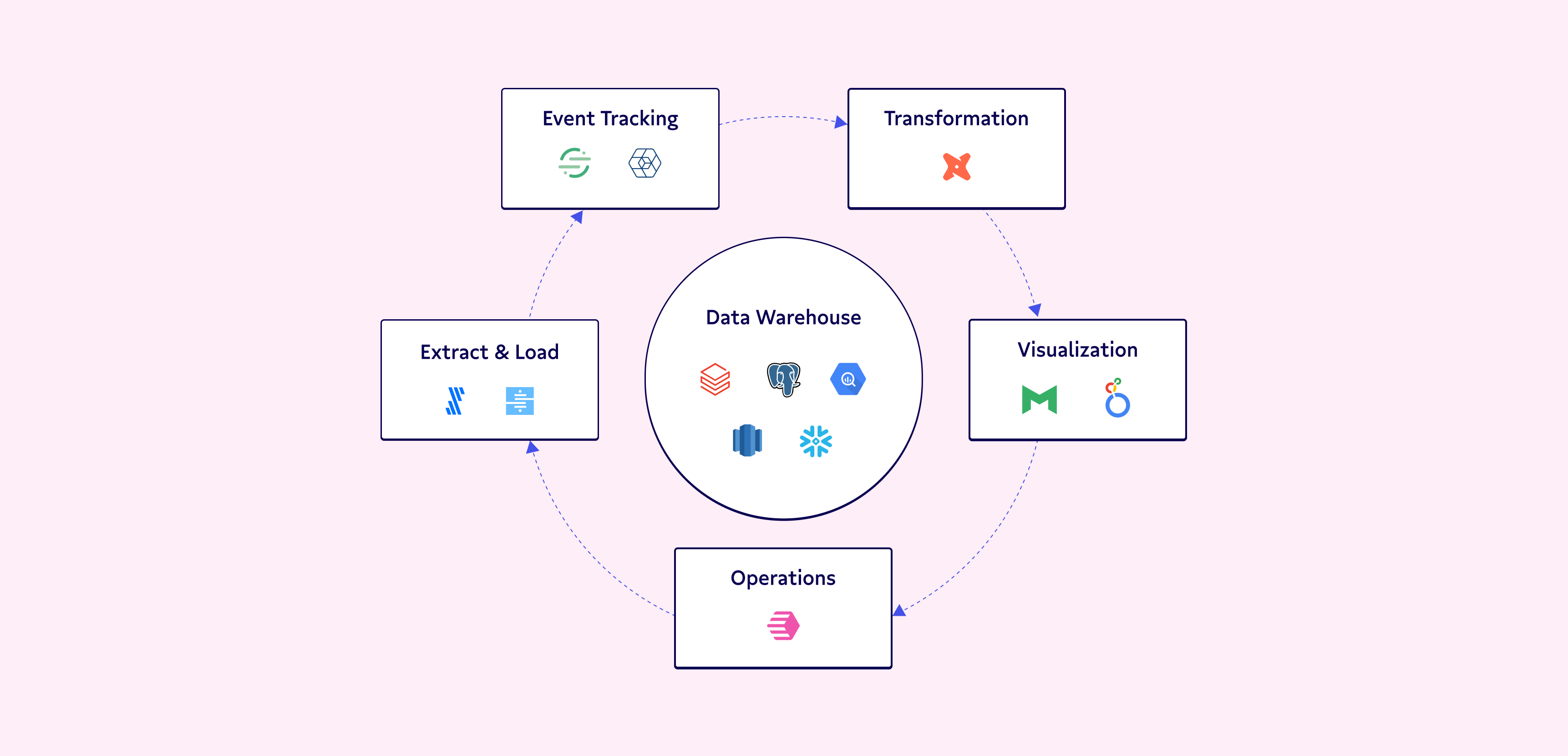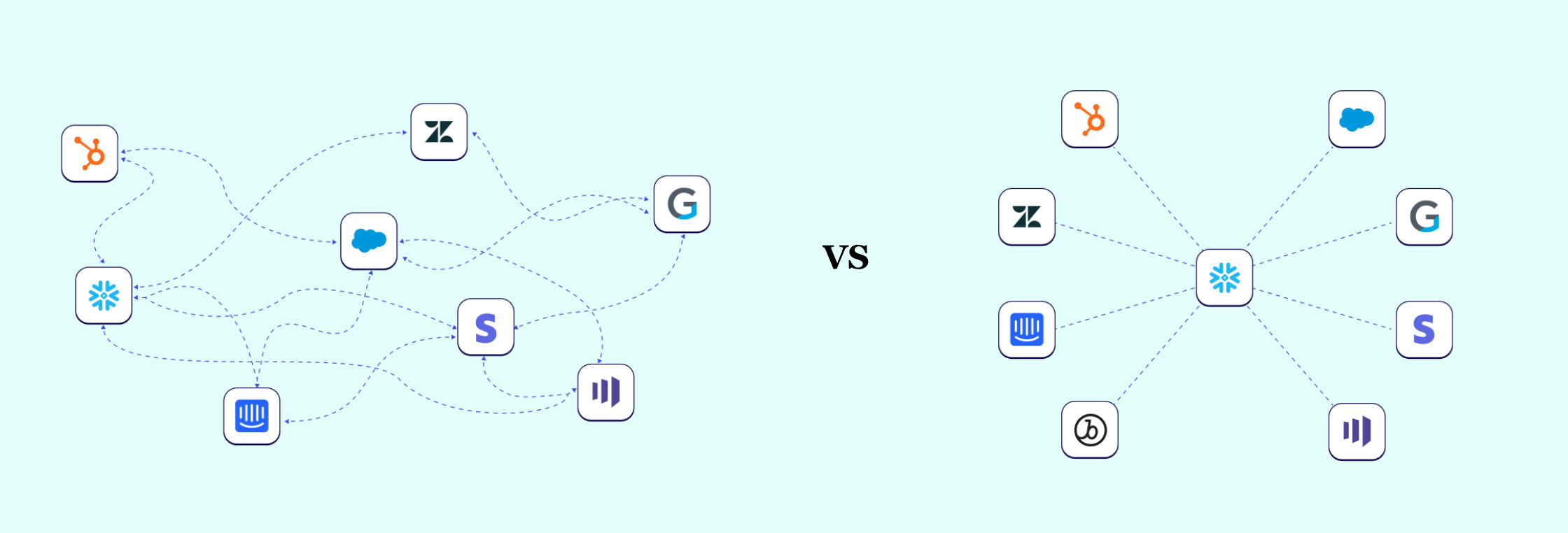Since we started Census, modern data stack adoption has seen phenomenal growth. But with that growth has come an even more interesting trend: the rise of the data team. Hiring in the data field grew a staggering 63% in 2021. We've seen this firsthand with hundreds of new customers who are rushing to meet their company's hunger for insights – and presenting them in dashboards isn't enough. With Operational Analytics, Census users can sync data directly into business tools and turn that data into a platform that powers all their critical workflows. This vision has been the driving force for our company since our earliest days, and today I'm excited to announce we've raised $60M Series B to make that vision reality for everyone. Tiger Global and Insight Partners joined our existing investors Sequoia and Andreessen Horowitz.
First came the stack
When we built the world's first reverse ETL tool in 2018, our focus was enabling product-led companies like Figma, Canva, and Notion to drive better marketing, sales, and customer success. At Census, we made a critical early decision: cloud data warehouses should be the hub for every business workflow, and can be used for so much more than powering a BI tool. Our customers have followed through on this vision by using Census to power more and more scenarios. These users were early to realize they could use this "stack" to empower more analysts and all sorts of operational tools. Today, even as the shift to the cloud is in its infancy (2/3 warehouses are still on-prem), the modern data stack has become a de facto standard.

This architecture shift has led to companies centralizing all their data in a single system, under the aegis of rapidly expanding data teams. Centralizing data creates a virtuous cycle in which more folks across the business have come knocking on their door to take advantage of this data. When everyone becomes your stakeholder, the default "service model" often used by IT does not scale (or worse, leads to duplicate shadow infra and analysts).
The better approach is to learn from the world of software & DevOps and treat data like a product (aka DataOps) by applying software product development principles like versioning, testing, monitoring, and, of course, continuous delivery not just to dashboards, but to every tool and team (via Census 🙂).
This approach is what we call Operational Analytics and it enables everyone across the company to have access to trusted data so they can take action and automate their business. It creates immense leverage, along with real pressure, on data teams to ensure they deliver! But the results speak for themselves. Here are some examples from the past year:
- Docker drove product-led growth (PLG) sales leads for more than 10 million users
- Canva delivers personalized customer marketing for more than 55 million users
- Bleach London reduced cost per acquisition by 20% across prospecting campaigns
And this is just the beginning. Hundreds of companies have embraced the approach of Operational Analytics, including Notion, Drizly, Webflow, and Figma. And we're building the platform for the next 10,000.
Now comes the platform
That brings me to why we've raised a Series B: to build and expand our Operational Analytics platform. The word “platform” is often overused, but our aim is to turn data teams into a platform to serve their organizations at scale (just like Shopify or Amazon enable sellers).

We’ve written about the chaos of traditional point-to-point data integration (and, chances are, if you’re reading this, you’ve experienced that chaos first hand). Our Operational Analytics approach solves this by making your cloud data warehouse a hub for all business processes and embraces the idea that data infrastructure (and teams!) should be in the critical path of live business workflows. This means our platform must:
- Deliver trustworthy data from a central hub. Our platform federates data from a single source (the cloud data warehouse) rather than arbitrary connections between apps and ensures data teams can model and monitor data from a single hub.
- Provide the best, most reliable data that “just works.” Our 60+ connectors have been battle-tested over years in production to handle obscure APIs and data type issues. Combined with unparalleled debugging and logging features, our customers know exactly what’s going on in the system as data moves.
- Reach any user at any scale. Census pipelines can operate at real-time latency and handle billions of records. As our library of connectors grows every week, teams can use high-quality data from the warehouse in any app and business workflow.
- Bridge the gap between data and ops teams. Ultimately, our goal is to get more people more data, and that can’t happen without Ops teams accessing core models built by their data teams. This is more than just dashboards, it’s a new definition of “self-serve” data: Ops teams can map data without SQL and data teams can maintain highly-visible, easily-monitored data lineage.
These are the core tenets we’ve built our platform upon. And there's a lot more to build to deliver on our vision. With this new funding, we plan to expand our library of connectors (more sources, more destinations, and more schema layers), build best-in-class introspection, introduce novel CI/CD capabilities, and build governance via an interconnected graph of all the knowledge in the business.
Then comes the movement
With the shift to Operational Analytics, data teams are poised to eat the business, just like software ate the world. It's never been a better time to join a data team (or to join Census!). These teams are growing everywhere and more folks are discovering this field – opportunities for growth & leadership abound.
I believe we can't build this with just tools; we need community and education as well, which is something we can contribute to with our additional funding. We've launched a dedicated community for data practitioners called the Operational Analytics Club, and have even more community projects in the works, which you can track here. You can also check out our podcast where I get into product, technical, and career conversations with amazing leaders from across the industry. Whether it's how we structure data teams, who data leaders should report to, how to be persuasive, what tools to adopt in the stack, there's tons to learn.
The real promise of Operational Analytics is to liberate data within a company, expand its “addressable market” by bringing more stakeholders to the table, and, ultimately, to deliver on our original dream: a central nervous system for the whole company that becomes indispensable for any business.
P.S.: You can reach me on Twitter or via email. I’m always happy to talk data.


















